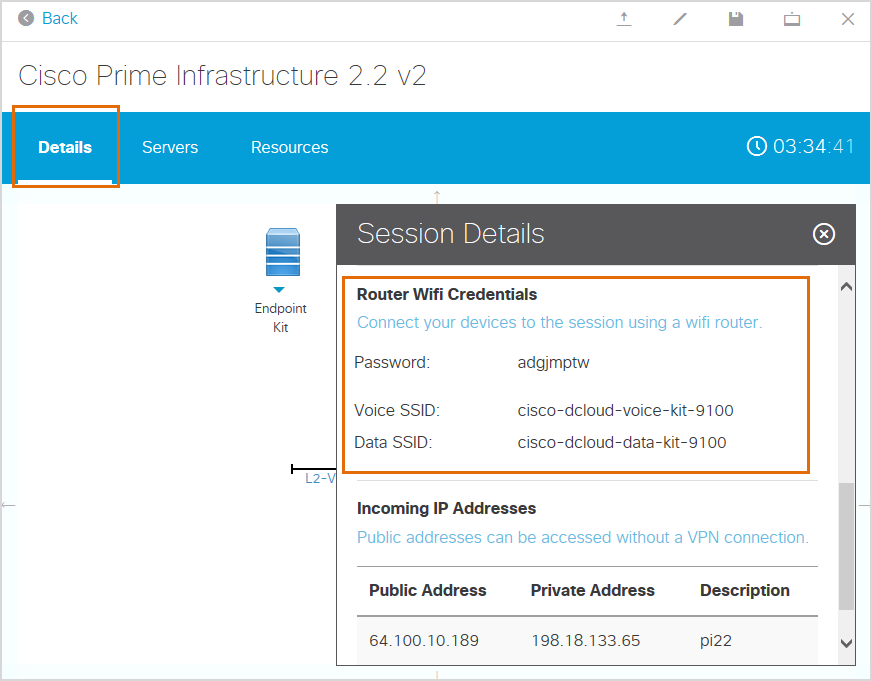Last updated: August 2016

Overview
Cisco dCloud content include support for wireless clients and devices.
Wireless connectivity is provided by Cisco Access Points (APs). Client connectivity to the AP is determined by how the AP is configured.
This document explains how APs operate within Cisco dCloud and how clients connect to the wireless network.
Access Point Mode of Operation
A Cisco Access Point (AP) is configured to operate in either lightweight mode or autonomous mode.
- LAP (Lightweight AP Protocol [LWAPP]) - A Cisco LAP is part of the Cisco Unified Wireless Network architecture. An LAP is an AP designed to be connected to a wireless LAN controller (WLC). The WLC manages the AP configurations and firmware; therefore, the LAP cannot act independently of a WLC. This mode is sometimes called controller-based. Enterprise Networking and Security content require lightweight mode.
- Autonomous AP - A Cisco IOS Software-based AP that functions independently of a WLC. This mode is sometimes called standalone. Collaboration and Customer Collaboration content require autonomous mode.
Access Point Connectivity
A Cisco AP can be included in most Cisco dCloud sessions. Cisco dCloud supports three (3) types of AP connectivity:
- Embedded - The AP is integrated into the router chassis. The 819W is a common example of this type of connection.
- AP behind an endpoint router - The AP is a separate physical unit connected to an Ethernet port on a Cisco dCloud configured router.
- AP only - The AP is a separate physical unit connected to the network through some other means.
AP Configuration for Enterprise Networking and Security Content
When including an AP in a Cisco dCloud session, the AP must be configured to operate within the session network. Enterprise Networking and Security content that support APs include WLCs and require that the AP is operating in lightweight mode.
- Lightweight APs require no manual configuration. The AP is configured by an LWAPP-capable WLC when connected to an Active session.
- If the AP is embedded in the router, such as with the 819W, the command to set the AP to lightweight mode is:
service-module wlan-ap 0 bootimage unified
This command is included in the configuration file for your dCloud registered router. - The AP receives its configuration from the WLC and broadcasts the SSIDs for the selected session. Refer to the content guide for session usernames and passwords.
AP Configuration for Collaboration and Customer Collaboration Content
All other content that support APs, including Collaboration and Customer Collaboration content, do not include WLCs and require that the AP is configured to operate autonomously.
- If the AP is embedded in the router, the command to set the AP to autonomous mode is:
service-module wlan-ap 0 bootimage autonomous
The AP configuration must also be applied to the AP as described in the configuration file. - If the AP is a physically separate unit, the dCloud configuration is generated and must be applied using one of the methods described in the configuration file.
Changing AP Operational Mode
Some APs can support both lightweight and autonomous modes of operation. This allows you to use your AP with content that requires lightweight or autonomous mode. Please note that this process is not convenient and requires expertise that is beyond the scope of this document. Refer to the following Cisco resources for more information:
- Lightweight Access Point FAQ
- Upgrade Autonomous Cisco Aironet Access Points to Lightweight Mode
- Converting Autonomous Access Points to Lightweight Mode
Autonomous Mode
When the AP is configured to operate in autonomous mode, and the configuration has been applied, the AP broadcasts the SSIDs shown below. The router ID assigned when you register your router is included in the name of the SSIDs, which use the following naming convention:
- cisco-dcloud-data-kit-[Router ID]
- We recommend the data SSID for use with laptops, tablets, and smartphones.
- cisco-dcloud-voice-kit-[Router ID]
- We recommend the voice SSID for with wireless IP phones.
The passphrase to access either SSID is: adgjmptw. You can find the SSIDs and passphrase for your router in the Details of an active session by opening View > Details > Session Details > Router Wifi Credentials:

Lightweight Mode
When the AP is configured to operate in lightweight mode, it receives its configuration from the WLC during an active session. Refer to the content guide for the SSIDs, user names, and passwords for sessions using APs operating in lightweight mode.